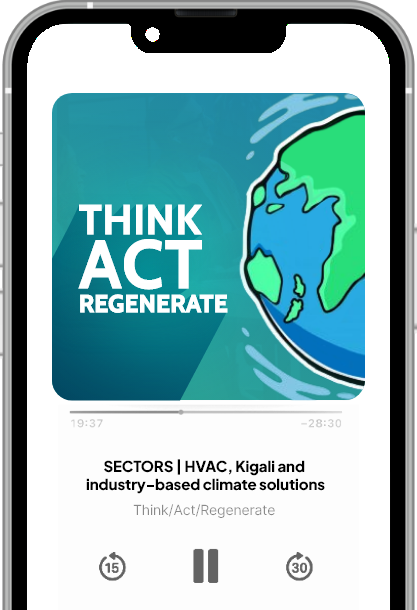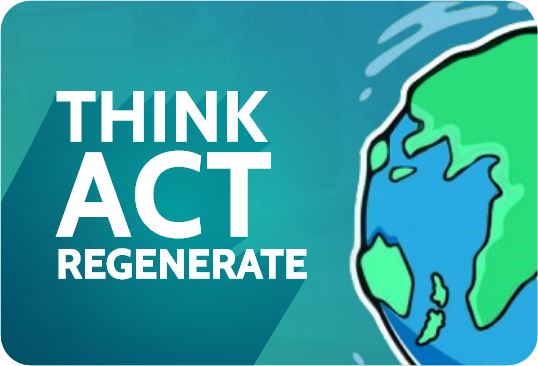
THINK ACT REGENERATE is a podcast by Leigh Baker of ThinkActRegenerate which explores the wealth of regenerative design solutions happening on the ground in Australia and New Zealand, as well as around the world.
In this episode, host Leigh Baker of Think Act Regenerate talks with David Hauser about innovative Melbourne battery-as-a-service startup ELIoT Energy – and the multiple benefits their business model offers customers, the hospitality industry, environment and community.
LINKS
ELIoT Energy website: https://eliot-energy.com/
10 key regenerative perspectives on regenerative business opportunity: https://thinkactregenerate.com/regenerative-design-insights/
FREE Think Act Regenerate INSIGHTS email series: https://thinkactregenerate.com/insights/
CREDITS
Original music composed for the show by Ian Hopkinson of HopkinsonCreative.com – used with permission.

In this episode, host Leigh Baker of Think Act Regenerate talks with David Hauser about his innovative Melbourne battery-as-a-service startup ELIoT Energy .
They discuss the multiple benefits their business model offers big organisations, the hospitality industry, environment and the community.
LINKS
Guest website: ELIoT Energy – https://eliot-energy.com/
Article: 10 key regenerative perspectives on regenerative business opportunity: https://thinkactregenerate.com/regenerative-design-insights/
Resource: FREE Think Act Regenerate INSIGHTS – introductory email series: https://thinkactregenerate.com/insights/
CREDITS
Original music composed for the show by Ian Hopkinson of HopkinsonCreative.com – used with permission.
TRANSCRIPT
Introduction
Hi there, I’m Leigh Baker, your host for this episode of the Think Act Regenerate podcast – where we explore the rich smorgasbord of solutions action and innovation that thinking more broadly about today’s challenges is delivering today.
This podcast episode was recorded and produced on a bush block in Wurundjeri lands, near Naarm, Melbourne Australia. So we might get some input from the local frogs and birds along the way.
In this episode, I’m taking a break from the Think Act Regenerate INSIGHTS to talk to a local entrepreneur and solutionist working in the energy space.
I’m talking to David Hauser from local startup ELIoT Energy. The ELIoT Energy story is a fascinating example of smarter design thinking and a solution creatively engineered using today’s existing technology to deliver some really big goals.
One of the reasons I wanted to do this interview with David was that the ELIoT energy business model demonstrates several key regenerative business principles – all at the same time.
If you’re a regular listener, then you’ve heard about the 10 keys to doing regenerative business innovation. For new listeners, I’ll just run through them quickly.
10 regenerative business keys
Number one is to take an opportunity focus rather than noble compliance.
Number two is to make regeneration your primary goal and plan for win-win win multiple benefits for whatever it is you’re doing.
Number three is to explore circular supply chain opportunities.
Number four is to focus on delivering service and value rather than merely products.
Number five is to apply biomimicry – updating existing industrial engineering practice with new techniques from physics and biology.
Number six. building solutions that are safe to make, safe to use and safe to dispose of.
Number seven is to focus on optimizing systems performance, not just an individual process or product.
Number eight is to move away from top down thinking and scan for local smart applications where you can use existing solutions in new ways to deliver high impact results.
Number nine is to keep in mind that business does not exist without its host ecosystems and communities. So regenerative business focuses on creating economic value BY delivering community value and ecosystem value.
And the 10th and final key is to build realistic strategies that allow for irrational human systems behaviors.
As I said, ELIoT Energy ticks off several of these boxes. And you might like to see how many you can pick as you listen through. I’ve put a link to a post about these 10 keys in the show notes if you do.
Interview
Welcome to the Think Act Regenerate podcast, David. I’m very pleased to have you on the show.
DavidH: Thank you very much for having me, Leigh.
LeighB: it’s been while since our first introductory conversation, so what I’d like to do is go back to the basics and you tell your story of where Elliott Energy came from and why you’re doing what you’re doing.
DavidH:
Sure. It came actually out from accelerator in last August, September and October through the Antler program here in Melbourne and ended up with a co founder in the program who was working on plug and play batteries for residential applications.
We kept working together, figuring out that Australian legislation is not really supportive of feeding power back into a wall socket – the whole idea was NOT sustainable. Also, five or six already established competitors from overseas tried to establish that product in Australia over the years and did not succeed.
But at the same time, Coca Cola approached us through Climate Salad. And they said that they have a problem with scope three emissions with point of sale cooling appliances – which are display fridges and vending machines with Coca Cola branding or any other brand under the Coca Cola banner – to explore whether smart batteries like ours (slightly modified to our design) would actually be a suitable solution to help them reduce those scope three emissions.
[00:05:35] LeighB:
Scope 3 emissions when the big corporations, have done Scope 1, which is their in house emissions, and then they’ve done Scope 2, and they’re starting to worry about Scope 3, which is the emissions of their customers that their product creates.
DavidH:
Scope three emissions are the indirect, emissions of suppliers and customers. So basically suppliers and customers scope two emissions [00:06:00] become Coca Cola’s or other beverage companies scope three emissions.
Our customers, that we’re targeting are,= the beverage bottlers and, producers themselves. Started with Coca Cola, we have traction with Asahi, and we’re now, advancing with PepsiCo. Those are our target customers because they own those cooling appliances, in between the three big here in Australia, they operate about 120, 000 of them.
It is much easier to roll out a large amount of batteries faster than when you have to negotiate and every grocery, or hospitality businesses themselves.
LeighB: The hospitality businesses Coke’s customers and your users.
DavidH: Yes, the bottler’s customer or retail partner – I call it retail partner.
LeighB: It’s big number of refrigerators. Most people who are buying a drink wouldn’t even stop to think about who owns a refrigerator. Much less who pays the power bill.
[00:06:57]
DavidH: Neither did I… Now, whenever I see a branded fridge or vending machine, first thing I do take a photo and see how it looks like and how a battery could fit in there.
We are trying to get conversations started with everyone who runs point of sale cooling appliances, but also any electrical appliance – coffee vending machines for example, as well. We are a little bit slow on the frozen product front because it’s riskier. You can spoil frozen product if your early-stage battery is not working exactly how you want it to. We want to avoid that risk so we’re sticking to beverages to get started.
LeighB:
That makes a whole lot of sense.
We talked about how many refrigerators there in hospitality venues around Australia and how big an opportunity it is and how quickly that can have a big impact – because there are lots of fridges but a much smaller number of beverage companies.
[00:07:52] DavidH:
It is, and the number that we’ve mentioned, that’s just the bottlers the 120,000.
When we look at the numbers of vending machines and add the potential of fridges that are not owned by bottling companies to it, we’re talking about a potential market of 3 million appliances in Australia that our batteries could be attached to.
LeighB: We should probably also point out that why this is important is around just how much impact those refrigerators have, or refrigeration in general has on environmental issues.
DavidH: Definitely. What’s the number?
About 74 percent of all fossil fuel burning is going into energy generation – and 20 percent of that energy is going in commercial refrigeration and cooling. So it is a massive opportunity and a massive problem that needs to be resolved.
LeighB: the good news is, that we have solutions.
[00:08:44] DavidH:
We just have to get it out there. And that’s one of the big benefits of our proposal as well.
We do not need any permits, or have to ask anyone if we can put our batteries into a location. We do not “install” it.We do not feedback [to the grid].
So we do not have to ask a council or a landlord or a body corporate. Our batteries can just plug in and be installed within 10 minutes by anyone – no electrician required.
LeighB: so you just need to plug the battery into the wall and the fridge into the battery.
DavidH: Exactly.
LeighB: And I assume there’s a communications component involved to capture data and transmit data? Tell me a bit about that.
DavidH: Yes. The batteries are smart.
The whole trick is that we’re using the intermittency of renewable energy in Australia.
We have a lot of solar power, especially from roof solar installations. And the problem at the moment is not that we do not have enough of it.
The problem is that we do not have enough storage capacity to actually make best use of the middle of the day solar overproduction.
So our batteries will run on board algorithms that will connect to the internet; will measure the usage of the appliance that is connected; AND also match it to the energy mix in the location where they installed.
And then they will make a decision when is the best time to actually charge the battery with the greenest energy available – so that the appliance that is attached can run 24 seven on that green energy.
We record that, we track it.
We calculate the carbon footprint of the energy that is going in. We calculate the carbon footprint of the energy if we would not have one of our batteries. And that’s what we report back to our customer, to let them know how much carbon they actually did NOT emit to operate their appliance.
LeighB: Because they saved up renewable energy for the middle of the day and used it in the peak.
DavidH: Exactly.
LeighB: when you’re doing that, I would imagine that the hospitality venue also gets a benefit.
DavidH: Yes. we think of that. So as always with a battery, there is a stack of value that we have to add up to make a compelling business case.
Once we have sufficient batteries out there, we can work with energy traders that are trading the spot price market to create value.
We can work with energy retailers, for energy arbitrage purposes.
And together with energy retailers, we can then offer dedicated energy contracts for the end users – the hospitality and retail businesses and grocers – to actually work on reduced energy costs contracts and reduce their bills.
LeighB: What you’re doing is very good for the network operators as well, because you’re smoothing out their load. You’re taking away some of the peak load Using some of that daytime energy that they almost have to throw away, sometimes.
[00:11:41] DavidH: Exactly, we’re buffering the peaks off.
Interestingly, a probably second implementation or horizon for us is that we can implement a control loop or control mechanism into the batteries that are actively offering recast capability.
So helping out with the frequency control – and helping with the voltage control of the small networks that there are in, in suburb, for example.
LeighB:
Probably most people don’t think about the electricity coming into their house, and just what the quality is, and, that the smoother the voltage is, the better, is what I think you’re saying.
DavidH: Yes, some people might have heard of “pure sine” inverters for camping applications. Our high performance electrical appliances – like our computers, our phones – they’re not very good in coping with dirty electricity.
So ripples in the sine curve – frequency variations and stuff like that – it can actually damage them quite easily. What we get from the grid is high quality normally – in frequency and amplitude – but it can be better. And the battery is a great tool to actually create the best quality of frequency and voltage.
[00:12:51] LeighB:
That’s why computers have UPS units – to protect against dirty power coming in from the grid. And if you assist in cleaning up the power from the grid in little pockets, you add yet another benefit to energy networks as well.
DavidH: Exactly. And not just in between the battery and the appliances plugged in, we can also help with, smoothing out the voltage differences in the grid itself.
LeighB: While you’re not – in our traditional way of thinking about home batteries – plugging into the grid to feed back into the grid, you still clean up the grid.
DavidH: Yes, and that’s an important task and value that we get out of decentralised, energy storage rather than that big utility size – we actually help to reduce the investment costs of grid upgrades.
AEMO and CSIRO are estimating that $20 billion will be required upgrading the grid for the transition to 100% renewables. The more decentralised small batteries we get into locations – on the generation side as well as on load side – the cheaper those grid upgrades will be.
LeighB: Yes, I think I’ve heard that said about EVs as well
DavidH: Exactly, yes.
[00:14:04] LeighB:
That’s going to be another way that the grid upgrade cost may not be as big as the worst case scenario, because lots of small batteries everywhere – in cars and appliances – helps do localised clean up of the power supply. Excellent.
So we have a model of what you do, which is lots of batteries on refrigerators around the place at the moment. And with world domination in mind…
I’m flashing back to an episode of South Park and the underpants gnomes, who went around stealing underpants off people’s washing lines, and what they were doing was “Step one is collect underpants. Step three, world domination.”
And the guy they’re talking to says, what’s step two?
And they go “don’t know yet, but we’re going to keep collecting underpants.”
You’re stepping into (I think) some of that step two hole.
[00:15:06] DavidH:
We have some interesting ideas for that. World domination for us means that we’re not limited to our own batteries – our physical batteries anymore – but we’re using our infrastructure to allow third party manufacturers to connect their decentralised energy resources to our control platform and reporting platform as well.
LeighB: Okay. having got all excited about where the future can go with this, where are you at the moment?
DavidH: Great question.
At the moment – since May – we are part of a PepsiCo sponsored greenhouse accelerator, which brings 10 of the most promising sustainability startups from all of APEC together into one cohort.
All working closely together with PepsiCo management team to implement their solutions for sustainability in ag tech, energy and carbon reduction – into the supply and distribution chain of the whole PepsiCo network.
So that is very exciting for us that we’re getting really deep insights into the operation of this 300,000 people organisation, being able to talk to people and learn from people within the organisation that we would hardly ever have a chance to talk to. And really understanding deeply what their challenges are now, and also over the next 10 years. And how our solution can actually help them to achieve their sustainability goals.
LeighB: And who would be the ideal person listening to this podcast that you would like to go, I like that. I want them. who’s your ideal listener?
[00:16:42] DavidH:
Anyone who on a daily basis thinks about or touches point of sale electrical appliances.
So who is installing vending machines or display fridges? Who is negotiating with retail partners what’s the best location for those appliances? Because we can help those people to get their appliances into a better location and create more value for everyone involved.
Three weeks ago, we also won the city of Melbourne open innovation competition, first place, very exciting.
And our pitch to the city of Melbourne was – and still is – that we can help them solve the energy storage gap in the municipality much faster and for lower costs than their current neighborhood battery project initiatives can do.
A little bit of background information to that. In 2021, the city set the goal to have five megawatt of power installed in neighborhood batteries throughout the municipality by 2024. It is now 2024 and only 450 kilowatts will go online – so that’s about 9% of the goal.
And it’s not because the people are not motivated and do not work hard. It is just really challenging to get all the stakeholders on board, and find the right location, negotiate with all the stakeholders, and really get such a project going.
And we feel that we can probably roll out energy storage 10 times faster than a neighborhood battery, the same capacity for half the price.
LeighB: And is there a particular sort location that you’d be putting your batteries?
[00:18:30] DavidH:
Horizon one – we stick with one group of appliances. So we stick to the fridges and the vending machines. But in this case, with the city of Melbourne, it would not be the bottler who is our customer. It would be the city of Melbourne or their energy retail partner who would be our customer for the batteries and our service.
And they then would place the batteries in the retail and hospitality stores that they sell the energy contracts to.
LeighB: There are a lot of those in the city of Melbourne.
DavidH: Yes. We estimate just for the city of Melbourne, the municipality, that there are about 100, 000 suitable appliances for Elliot battery.
LeighB: Excellent – we live in exciting times, don’t we?
DavidH: We do.
[00:19:19] LeighB:
One question I haven’t asked before, the name ELIoTEnergy, is that a play around Internet of Things?
DavidH:
It is. I played around with the name Eliot for other startups that had nothing to do with batteries or hardware at all in the past.
It is a combination of things. It’s Eliot. And now we say it’s the electrical internet of things. The original idea was for a startup where we wanted to create a companion – an AI companion for people – similar to the co pilot which Microsoft just rolled out.
And we thought, okay, who do we trust the most as an alien, who is on planet earth? Our best friend is Elliot – who really understands our needs better than anyone else. [E.T. the movie].
LeighB: cool, that’s been a question that’s been on the back of my brain for months now, I’m glad to have it resolved.
[00:20:12] DavidH:
To achieve our sustainability goals, our net zero goals over next 10 to 15 years, we have to increase our energy storage capacity by 1000 percent minimum. And it’s not just small batteries – it also includes large long term storage, pumped hydro and things like that.
We need it all. We need the big ones to bridge the longer gaps to get us through the winter – and we need the small ones that are 24 cycle, making the energy usable.
LeighB: So making the daytime renewables usable 24 hours a day.
DavidH: Exactly, yes
LeighB: we’ve talked about, how the battery proposal works and we’ve talked about, who your customers are and what you’re doing.
To me, this is an example of a, circular economy insights turning a product into a service, You stop worrying about who owns the battery and you start working out who’s going to get the most value from it as a service. Does that make sense to you?
[00:21:11] DavidH:
It makes complete sense to me because our business model actually is battery as a service. We’re not planning to sell the batteries, but provide the different services for a monthly fee to different customers.
We mentioned the value stack of batteries earlier. So to make it an attractive financially viable solution, we will own the batteries and rent out different capabilities of the battery to different customers.
LeighB: so this is a good offer for Coke, because they don’t have to suddenly buy thousands or hundreds of thousands of new assets.
DavidH: That’s right.
So for our customers in the food and beverage industry – PepsiCo first – the batteries are plug and play. Therefore they do not have to throw fully working beverage fridges and coolers out and replace them with new ones.
They can just add our batteries and the batteries will not add to their CapEx. It will be just a small addition to their operational expenses.
LeighB: And the same goes for the hospitality venue. They don’t have to buy a battery – they don’t have any disruptive installation. They just need to plug the battery into the socket where the fridge was plugged anyway.
DavidH: Exactly, exactly. Yes.
And very important – to battery as a service – since our customers are not buying the product and just getting the service, any carbon emissions that we generate in our operation will not go onto the carbon account of our customers.
LeighB: And that’s got to be important for the big beverage companies. They’re doing this to reduce their carbon.
DavidH: exactly.
LeighB: and the other benefit that I think we’ve talked about was the life of the refrigerator itself is extended.
[00:22:49] DavidH:
Yes, as we spoke earlier, good quality electricity is important for any electronic appliance. So by having better quality sine wave frequency powering the appliance, we will help to increase the life of the fridge or the vending machine as well.
And at the moment, as we understand the average life of those appliances in the range of 8 to 12 years. Our batteries will last 10 to 15 years. So if we can help extend the life of the appliance by 25%, then we would match the 15 years -and battery and appliance would be a perfect match.
LeighB: The beverage companies that own the refrigerator get an extra five years of life out of it. It is a good thing. for the environment – an extra five years of life out of the refrigerator before having to replace it is a good thing.
LeighB: Very interesting.
DavidH:
It is. It is a steep learning curve from the original idea. The conversations that we have with different people learning new things each and every week. How we can actually add more value with our solution? It’s really, really interesting.
[00:23:59] LeighB:
It’s absolutely fascinating what happens behind the retail shop front. That’s my background as a manufacturing business analyst for 20 odd years.
What happens in the factories and the warehouses and behind the scenes – that’s invisible to most people – is just SO important.
DavidH: It is.
Talking about invisible – visibility is actually one of the benefits of our product as well compared to other battery solutions.
It’s still earliest times for us here in Australia to accept batteries in our lives. And most of the batteries are hidden away. So it’s not something that people interact with consciously on a daily basis.
Now, our batteries will be very prominently sitting on top or underneath a vending machine and a display fridge or a coffee maker.
And whenever a customer comes along, they will actually see our battery and they will get instant feedback that – using or buying a product from a machine that is powered by Elliot battery – that they’re actually contributing to accelerate the energy transition and reduce carbon emissions with their choice.
[00:25:15] LeighB:
The biggest predictor of the take up of solar panels in a neighbourhood is how many solar panels there already are on the roof.
Okay, the more you put nice compact batteries in front of people as a safe and accessible solution, the more you build a willingness to accept a battery.
DavidH:
Yes. Yes.
And it all starts with starting a conversation. If I haven’t thought about batteries yet, but three times when I walk through the city of Melbourne I see one of those batteries. At some point I will ask the manager of a store or a restaurant “What’s going on with that battery?” and start a conversation and learn from this first adopter – what are the benefits? Why they do it. And that makes me want to have it as well.
LeighB: It’s got real potential for behavior change At consumer level, because it’s prominent in a retail level.
DavidH: Yes.
LeighB: Excellent.
There’s a level at which you could go: “It’s a big corporation, toeing the line on measurement. And the product that they’re selling isn’t particularly good from a nutritional point of view.” Bbut they are big – and they can be big change agents.
[00:26:34] DavidH:
They are. And, as I said, we get deep insight into PepsiCo these days and PepsiCo is working on sustainability since 2015, I think , they introduced a program which is called PEP plus.
Sustainability initiatives are part of the KPIs of each and every one within the PepsiCo organization and over the last nine years, they actually already saw that sustainable practice contributes to business growth.
LeighB: The CEO of Project Drawdown – a solutions cataloging platform – Dr Jonathan Foley said “Some people aren’t going to have a great time. But for most of us, this is the biggest business opportunity in human history.”
DavidH: it always is for someone
LeighB: The digital revolution wasn’t that good for Kodak, the car revolution wasn’t that good for the horse industry. But new industries arose, created jobs, increased prosperity.. The world changes.
DavidH: And it will keep changing
LeighB: Is there any question I haven’t asked that I should have?
[00:27:44] DavidH:
Probably what are immediate next steps?
So we’re working actively on getting pilots out. We’re now in process of designing our first physical battery prototype. We’re very positive on the software layer that we have that covered for pilots.
So we’re looking now forward to launching our first pilots within the food and beverage industry together with PepsiCo.
And also exploring opportunities to get into a pilot together with the city of Melbourne to prove our hypothesis that we can replace neighborhood batteries, faster and cheaper.
So we’re happy to have conversations with, other potential pilot, customers – anyone whose interested to give it a go. That’s the big ticket item for the next six to 12 months.
We have a physical product. The cost will go down the more we can build.
But before we want to build, we want to really be very close to a form factor that really meets the customer requirements. Size and how to install it and things like that.
So doing testing with prototypes, pre production models, before we go into large scale manufacturing is really important for us to have a positive customer experience further down the track.
LeighB: It sounds fascinating. I’m going to want to talk to you in, say, six to twelve months and see where you’re up to.
DavidH: I would be more than happy to come back. Thank you so much.
LeighB: Thank you so much for your time today.
Regenerative key count
So that was my interview with David Hauser of ELIoT Energy. I found it fascinating.
I wonder – how many regenerative business key principles did you tick off? I counted seven.
Firstly an opportunity focus towards a more value instead of less harm.
Secondly they were about win-win outcomes for multiple stakeholders – adding value for corporate customers, hospitality venues, and power retailers, with flow on benefits to ecosystems and communities.
The very obvious one was number four – the service flip. ELIoT is all about battery as a service. They’ve gone way beyond “One battery equals one sale.” Instead they’re building a battery network that offers multiple value propositions to multiple players in the energy space.
Next one was number seven. Taking a systems perspective with a focus on designing around existing constraints with the Australian grid.
Next was number eight. They going small and smart. They’re not trying to invent and roll out a whole new battery technology. They’re taking existing technologies and using them differently and adding value with smart information systems and services.
Built into their model is value delivered to communities and ecosystems. In reducing energy costs, grid costs, and overall emissions.
And number 10 – they’re tackling the human in the equation. Dealing with regulation that restricts feedback. And also starting to tackle the perception of batteries in the community – a product often resisted on cost and unknown and risk. Their design includes creating visibility about batteries as useful and helpful things.
That’s my count. I’d be interested to know if you picked up other benefits or other themes.
Thoughts
Today’s accelerating developments in regenerative business design and restorative economic models – and particularly in designing and delivering value based service models – mean we don’t need to wait for more scientists to invent more technology.
We don’t need to wait for some government somewhere to create a better policy.
We could use. a whole lot more entrepreneurial thinkers acting to deliver. more innovative business models with increased ecosystem and community benefits -using today’s solutions more creatively today.
And that’s what ELIoT Energy is doing. Along with thousands of other entrepreneurial thinkers across the full spectrum of industry.
They’re thinking more broadly, acting to create deeper impact, in order to regenerate their bit of the world today.
In my next podcast episode. I’ll be doing a deeper dive into the opportunities of service-based innovation. So, if you like, what. you heard today, subscribe to the podcast and follow along.
[00:33:00] The 10 key insights I talked about today are also available as a free email series from Think Act Regenerate. The link to that email series is in the show notes.
Thanks for listening to this episode of the Think Act Regenerate podcast – and my thanks again to David Hauser from ELIoT Energy. I’m Leigh Baker and I’ve enjoyed being your host for today.
If you liked the episode, then please leave a rating and review so you can help other people find their opportunities.
Now, it’s over to you to start exploring for your opportunities to be a regenerative business solutionist.
Be excited. Be very excited.












